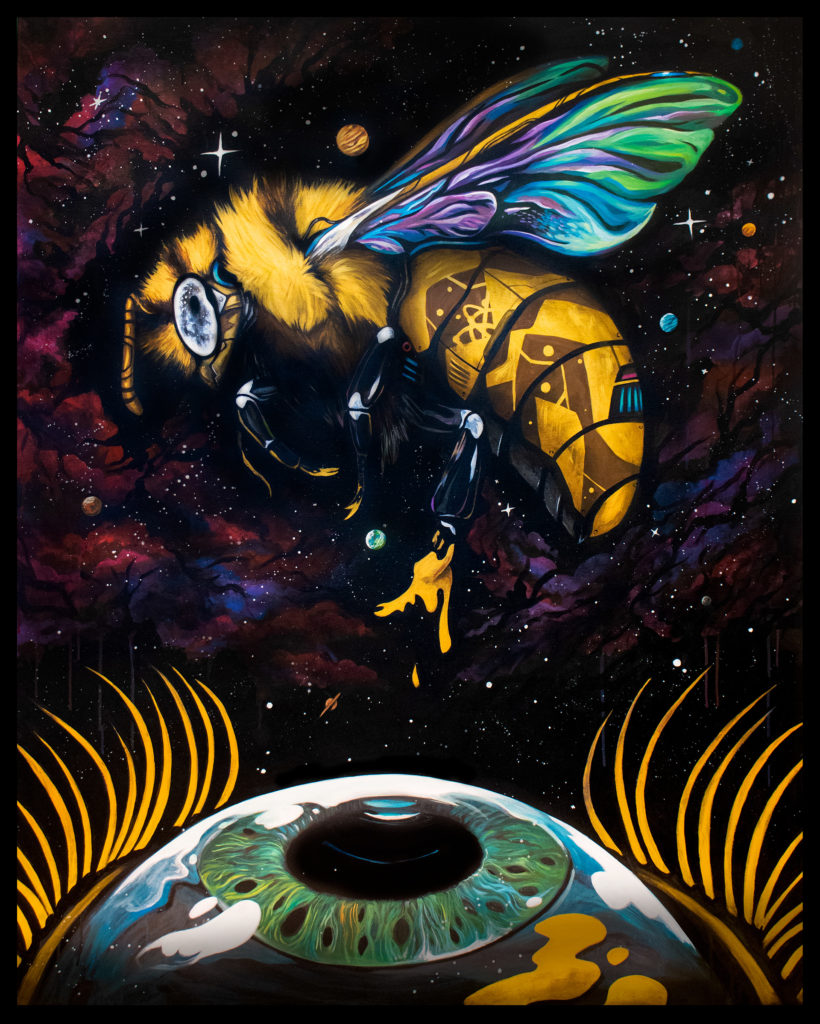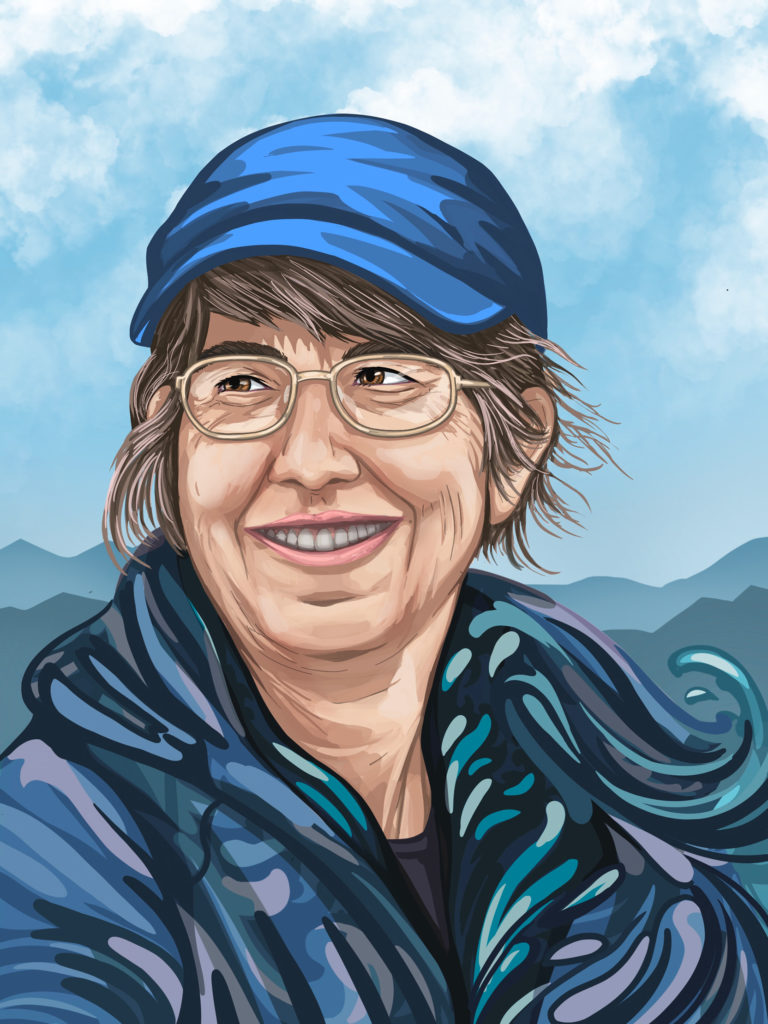Exhibitions Project Manager Sallyann Browning asked Kelly a few questions about her work, the 50 Windows project, and how she thinks art can help us all understand science better…
You describe yourself as a scientific artist and an advocate for science communication. Can you tell us a bit more about this? How did you get into this line of work?
In short, I take complex scientific topics and use my art as a medium to make these subjects more easily accessible and understandable to the public. I’ve always been interested in science so during college I naturally started doing art projects themed around scientific breakthroughs which were happening at the time like the Rosetta landing Philae on the comet 67p and developments at CERN.
I noticed that by doing this it seemed to get my peers, who weren’t interested in the slightest in STEM (science, technology, engineering and maths), to ask me questions about the science topics featured in my art. I saw the potential in using art as a science communication tool to get people into STEM subjects, so carried on down this path to where I am now. Working on my own science communication projects and also helping scientists from around the world communicate their research to the masses.

Credit: Kelly Stanford
Can you tell us a bit more about the story behind your entry to the 50 Windows of Creativity project that is currently being displayed at our museum?
In 2018 I collaborated with ARUP to create the ‘STEM Bee’—a 6ft tall science communication sculpture located outside Manchester Oxford Road station as part of the Bee In The City trail.
The bee aimed to raise awareness of Manchester’s scientific heritage, past and present. I designed the STEM Bee to incorporate imagery from scientific papers, facts, scientist portraits, poetry and signatures from 80 local researchers who came to sign the bee. The sculpture was then auctioned off, raising £22,000 for local charities. The window painting is essentially a celebration of this project’s success 3 years on.
How did you get involved with the 50 Windows of Creativity project, and can you tell us a bit more about the trail and the aims of the project?
I was contacted by the trail organiser who already knew me from my past work and thought I would be the perfect fit to design a piece for the Science and Industry Museum. I wanted to do a piece to mark the 3-year anniversary of the STEM sculpture project and act as an Easter egg for any local researchers who took part. I can imagine many visiting the Science and Industry Museum for a trip, seeing the painting and being like “hey I signed that bee!”
What does the world of a ‘scientific artist’ look like? Can you talk us through a typical or non-typical day?
Every day is a non-typical day. Because I’m a researcher and science communicator as well as an artist, my days are usually split between organising events, such as Pint of Science, doing stuff for my MPhil and whatever art project I have allocated for that day. It can be really hard to juggle it all but I manage… with the help of coffee!
I have weird work hours where the majority of art stuff gets done during the night to early morning and the day is reserved for sleeping/meetings. So don’t be surprised if you get an email response from me at 4am.
What one piece of advice would you give to someone starting out in your field of work?
I’d say don’t feel intimidated/put off approaching scientists for a collaborative project. You’ll find a lot of people in STEM welcome interdisciplinary work with open arms as they see its importance in boosting creativity and outreach.
Manchester was the European city of Science in 2016, and historically always been known as a science city. As an artist producing science-themed art/illustrations, what inspires you about Manchester and does it impact your working practice?
I actually volunteered every day at ESOF doing a mixture of supporting at the convention centre and science busking. I think the attraction of Manchester to me was how proudly the city celebrates its scientific importance and has a can-do attitude to projects.
When starting out as an undergraduate I really appreciated the University of Manchester’s openness. Even though I studied art history, that didn’t mean I wasn’t allowed to mix with the physics department. They happily let me walk in and ask questions about various particle physics topics and this eventually led to quite a few fun collaborations.
Can you take us through your process from start to finish when producing work to inspire the public and get them interested in STEM?
Oh, that’s a hard one to answer! My work is so diverse it’s really difficult to say as each project will have its open requirements. To give a simple answer I will take into account the format the artwork needs to be in (sculpture, painting etc.) and then figure out the audience and key goal for it. With the STEM Bee science communication sculpture it had a wide demographic with it being in a public place so the design had to have something for everyone.
Tell us a bit about the applications you use to make your work and the process you go through before you are happy with your final piece.
Again the art medium I use depends on the project and outcome I need to achieve, but for my digital work I mainly use an iPad Pro with Apple Pencil, Procreate for illustration and a MacBook Pro 2019 i7 running Adobe Photoshop and Illustrator CC for layout design. All ideas start with the world’s messiest concept scribble on the iPad which I use as a base layer and foundation for the artwork.
I then build my artwork up on multiple layers, constantly changing things and making alternative versions of a piece until it looks right. A piece can go through multiple changes. I usually send my collaborators ’sneak peeks’ of the work developing so that I can get feedback and make changes on the fly.
2020 really has not been a typical year for anyone. What do you think the future of your work will be like in the next few years? Will you take any learnings from this year in your future work?
Well as we’re nearing the end of 2020, I’ve switched from mainly drawing insects in my spare time to working on my scientist portraits. I incorporate their research into the portrait itself and they’ve proved really fun to draw so far. I want to expand that into doing portraits of historical Women in STEM seeing as a lot of photos of them are old and monochrome. It would be nice to have full-colour images of these brilliant scientists!
My other activities will be a mix of organising Manchester’s Pint of Science 2021 event and the SciArt session I’m running at EGU’s 2021 conference. I’m really excited for both of these as I’ve taken a completely different approach to the norm for these types of events, so fingers crossed it pays off. If I’ve learnt anything from this year it’s that remote networking and hosting events online may seem like a setback at first but in reality they offer a lot of potential to achieve things you couldn’t achieve in normal circumstances.
The Science and Industry Museum explores ideas that change the world. What at the museum has inspired you and do you recommend that visitors don’t miss?
I loved the Collider exhibit that was at the museum a few years back. Being able to look at the experimental hardware close up without having to fly out to CERN and worry about getting visitor clearance was really helpful for my research. I would highly recommend people check out any temporary exhibits, such as Collider, while they’re at the museum.
Permanent parts of the museum’s collection I’d recommend are the Manchester Baby computer, a working replica of the world’s first stored program computer, in Revolution Manchester, and the incredible English Electric Lightning P1A aircraft in the Air and Space Hall.
